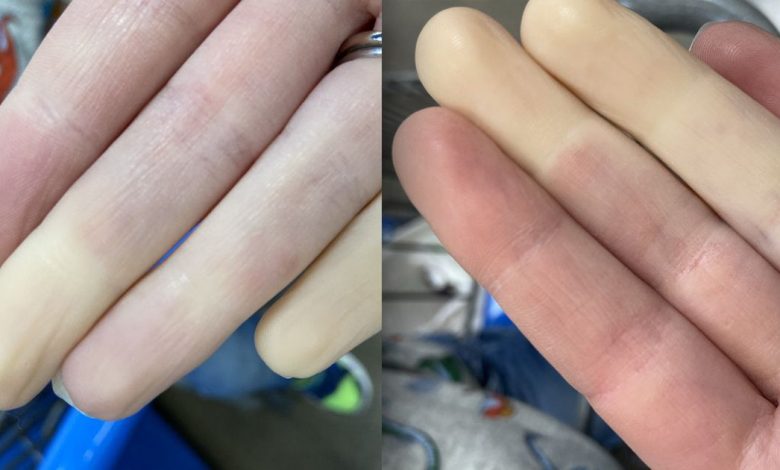Change in color of fingers and toes: what is this, causes, symptoms, diagnostics, treatment, prevention

Fingers that change color; Blanching of the fingers; Fingers – pale; Toes that change color; Toes – pale
Why does the color of fingers change?
Fingers or toes may change color, when they are exposed to low temperatures or stress, or when there are problems with their blood supply.
The color of the fingers can vary from light blue or purple to dark blue or black.. The condition is usually painless and harmless, but may be a sign of a more serious underlying condition.
Causes of discoloration of fingers and toes
The most common cause of finger discoloration is Raynaud's disease.. Raynaud's disease – This State, in which the blood vessels in the fingers and toes spasm, reducing blood flow and causing blue or pale fingers. Other causes of discoloration of the fingers or toes include:
- Buerger's disease
- Chilblain (painful inflammation of small blood vessels)
- Cryoglobulinemia
- Necrotizing vasculitis
- Peripheral artery disease
- Scleroderma
- Systemic lupus erythematosus
Symptoms of discoloration of fingers and toes
In addition to color change, people with discolored fingers may experience numbness, tingling and pain in the affected area. Fingers may also be cold or stiff., and in severe cases, the patient may have difficulty using their hands.
Diagnosis of discoloration of fingers and toes
Diagnosis “fingers, color changing” usually based on the person's symptoms and medical history. The doctor may also do a physical exam, including pulse check and visual inspection of affected fingers. In some cases, additional testing may be required to identify the underlying cause of the discoloration., such as x-ray, MRI or ultrasound.
Treatment of discoloration of the skin of the fingers and toes
Finger treatment, changing color, depends on the underlying cause.
If the cause is Raynaud's disease, drugs may be prescribed, as calcium channel blockers or nitrates to improve blood flow in affected fingers.
If the cause is frostbite, then the affected area must be warmed and treated with painkillers and antibiotics.
If the cause is peripheral arterial disease or scleroderma, surgery may be required to improve blood flow to the affected fingers.
Home treatment for discoloration of the skin of the fingers and toes
People, whose fingers change color, can take a few steps at home, to relieve symptoms. These include:
- Warming: Wearing gloves and warming affected fingers can help reduce the frequency and severity of color changes..
- Avoidance of triggers: Such triggers, how low temperatures, stress and smoking, may worsen symptoms, so people should try to avoid these triggers, as much as possible.
- Physical exercise: Regular exercise, such as walking or cycling, may help improve blood flow and reduce symptoms.
Prevention of discoloration of the skin of the fingers and toes
There are several measures, steps you can take to prevent finger discoloration, including:
- Wearing warm gloves: Wearing gloves in cold weather can help protect your fingers from the cold and reduce the risk of discoloration..
- Avoidance of triggers: Avoidance of such triggers, like stress and smoking, may reduce the risk of symptoms.
- To live an active lifestyle: Regular exercise can help improve blood flow and reduce the risk of symptoms..
In conclusion, it should be noted, that discoloration of fingers could be a sign of various underlying health problems, including Raynaud's disease, chilblain, peripheral arterial disease and scleroderma. Treatment for this condition depends on the underlying cause and may include medication., surgery or home treatments. Taking steps to keep fingers warm, avoid triggers and stay active, people can prevent finger discoloration and reduce the risk of developing symptoms.
Used sources and literature
Jaff MR, Bartholomew JR. Other peripheral arterial diseases. In: Goldman L, Schafer AI, eds. Goldman-Cecil Medicine. 26th ed. Philadelphia, PA: Elsevier; 2020:chap 72.
Robert A, Melville I, Baines CP, Belch JJF. Raynaud phenomenon. In: Hochberg MC, EM Gravallese, Silman AJ, Smolen JS, Vine leaf ME, Weisman MH, eds. Rheumatology. 7th ed. Philadelphia, PA: Elsevier; 2019:chap 154.
